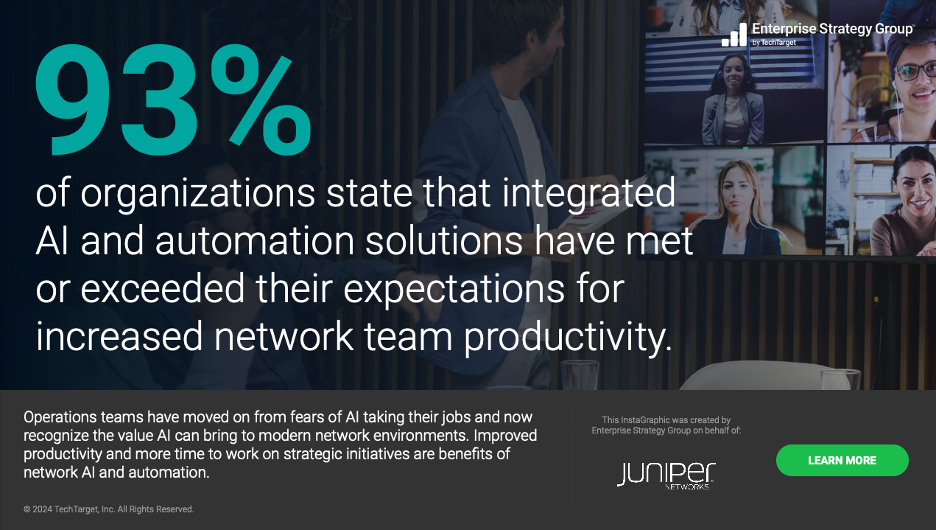If your organization hasn’t started adopting AI and automation to help overcome network complexity, a new survey suggests it’s a fruit that’s ripe for the pickin’.
Enterprise Strategy Group (ESG) recently surveyed 362 network professionals in the US and Canada involved with network AI and automation technology and processes to gain insight into the current role of AIOps in network infrastructure operations. The results are published and available as a free eBook: The Role of AIOps in Network Infrastructure Operations.
Specifically, ESG set out to gain a better understanding of:
- How AIOps maturity impacts an organization’s ability to manage modern network environments
- Current adoption levels of and use cases for AI/ML and automation in network environments
- Benefits perceived/achieved by organizations at varying stages of adoption and maturity
Insight #1: AIOps is steadily gaining ground
AI for network operations, or AIOps, is working its way into companies of all sizes. These organizations report increasing the number of processes that leverage AI in the network environment. The survey found there is a direct correlation between the length of time an organization has had AI deployed and the number of processes it is leveraging.
- Over half of organizations that have been using AI for three or more years report that 41% or more of their processes leverage AI
Juniper customers benefit today from the AIOps delivered in the Juniper Mist solution, which learns about your unique network environment, helping you streamline your network operations.
Insight #2: Fully automated remediation is on the rise
While the intelligence delivered by AI can be used to provide alerts, there is even greater value to organizations when it also provides recommended solutions or directly drives an automated fix.
According to ESG’s survey findings, organizations with more mature automation or AI environments were much more likely to be in the fully automated stage, indicating that organizations are becoming more comfortable with the technology, overcoming cultural hurdles, and recognizing its value.
- 33% use network AI/automation software for alerts, but retain full manual control of analysis and remediation actions
- 38% use the software as an alert and recommendation engine, but handle implementation and execution of recommendations on their own
- 29% of respondents are comfortable leveraging network AI/automation software in a fully automated and autonomous way
Trust and transparency through explainable AI (XAI) are helping organizations to become more comfortable with dependance on fully autonomous AI.
Insight #3: Network AI adoption spans a wide range of use cases
Organizations are increasingly leveraging AI to quickly spot anomalies (both network- and security-related) and enable proactive, if not automated, responses. Other use cases include help with planning, maintaining, and scaling the network. Additionally, the use of AI and automation is gradually beginning to enable self-healing networks.
Use cases serving as drivers for AI in network environments, according to respondents:
- 40% – Network performance optimization
- 38% – Security threat detection
- 34% – Traffic analysis and optimization
- 33% – Network capacity planning
- 32% – Load balancing
- 31% – Anomaly detection and alerting
- 30% – Predictive maintenance
- 28% – Dynamic network scaling
- 24% – Action recommendations
- 23% – Self-healing
At the end of the day, the goal of AI for most organizations is to achieve a better end-user experience and better operational experiences for IT teams.
Insight #4: AI technology is becoming more widely accepted
Network automation isn’t without its challenges. According to survey respondents, these include data quality (28%), increased security risks (27%), configuration complexity (26%), data availability (25%) and explainability and transparency (23%). These challenges aside, only 17% of organizations cited cultural resistance to AI use, suggesting that AI technology is becoming more widely accepted.
Insight #5: Integrated solutions deliver real business value
Survey respondents were more likely to report using an integrated AI and automation solution than standalone tools.
Compared to standalone tools, respondents favored integrated solutions for the following reasons:
- 74% – Reduces downtime and/or makes existing resources more productive
- 68% – Easier/simpler to evaluate and/or purchase
- 59% – Lowers operating costs and/or yields faster time to value
AI is simply a natural step in the evolution of automation, serving as a lever to improve operational efficiency in the network.
Insight #6: AI/automation is driving network security improvement
Survey respondents are overwhelmingly using network AI and automation solutions to bolster their organization’s cybersecurity posture. For teams managing modern, distributed environments, the ability to quickly detect threats is required to stay ahead of an ever-evolving threat landscape.
Reported security drivers for AI in network environments:
- 62% – Improved speed of threat detection
- 57% – Accelerated troubleshooting
- 54% – Accelerated network device/entities identification
- 52% – Improved accuracy of threat detection
- 49% – Supported automated security response capabilities
- 48% – Identified gaps or issues with security policies
- 42% – Identified network-based anomalies
AI is well suited to finding needles in haystacks. For security applications, modern machine learning techniques can uncover elusive anomalies and other characteristics of cyberattacks.
Insight #7: Generative AI is finding a place in network operations
Organizations with more mature AI and automation environments are more likely to have generative AI in production. Use cases typically vary by organization, but generative AI can prove particularly valuable for complex cloud-native application environments. Examples include topology generation, traffic modeling, resource allocation, and dynamic quality of service (QoS).
Generative AI will be key to improving daily network operations. For example, Marvis continues to gain GenAI capabilities, such as helping deliver documentation knowledge to network teams.
—
While some operations teams struggle to keep their heads above water in the face of staggering network complexity, others are leveraging integrated AI and automation solutions, such as Juniper’s AI-Native Networking Platform, to help deliver highly available and secure connectivity to every application, location, and employee.
For the full survey results and ESG’s analysis, get your copy of the free eBook: The Role of AIOps in Network Infrastructure Operations.



























